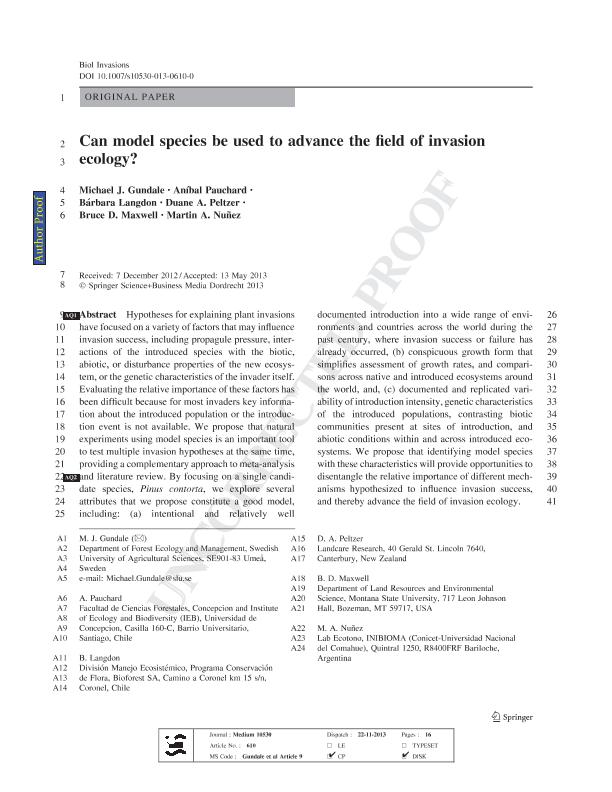Mostrar el registro sencillo del ítem
dc.contributor.author
Gundale, Michael
dc.contributor.author
Pauchard, Aníbal
dc.contributor.author
Langdon, Bárbara
dc.contributor.author
Peltzer, Duane A.
dc.contributor.author
Maxwell, Bruce D.
dc.contributor.author
Nuñez, Martin Andres

dc.date.available
2017-01-24T20:46:11Z
dc.date.issued
2014-01
dc.identifier.citation
Gundale, Michael; Pauchard, Aníbal; Langdon, Bárbara; Peltzer, Duane A.; Maxwell, Bruce D.; et al.; Can model species be used to advance the field of invasion ecology?; Springer; Biological Invasions; 16; 3; 1-2014; 591-607
dc.identifier.issn
1387-3547
dc.identifier.uri
http://hdl.handle.net/11336/11867
dc.description.abstract
Hypotheses for explaining plant invasions have focused on a variety of factors that may influence invasion success, including propagule pressure, interactions of the introduced species with the biotic, abiotic, or disturbance properties of the new ecosystem, or the genetic characteristics of the invader itself. Evaluating the relative importance of these factors has been difficult because for most invaders key information about the introduced population or the introduction event is not available. We propose that natural experiments using model species is an important tool to test multiple invasion hypotheses at the same time, providing a complementary approach to meta-analysis and literature review. By focusing on a single candidate species, Pinus contorta, we explore several attributes that we propose constitute a good model, including: (a) intentional and relatively well documented introduction into a wide range of environments and countries across the world during the past century, where invasion success or failure has already occurred, (b) conspicuous growth form that simplifies assessment of growth rates, and comparisons across native and introduced ecosystems around the world, and, (c) documented and replicated variability of introduction intensity, genetic characteristics of the introduced populations, contrasting biotic communities present at sites of introduction, and abiotic conditions within and across introduced ecosystems. We propose that identifying model species with these characteristics will provide opportunities to disentangle the relative importance of different mechanisms hypothesized to influence invasion success, and thereby advance the field of invasion ecology.
dc.format
application/pdf
dc.language.iso
eng
dc.publisher
Springer

dc.rights
info:eu-repo/semantics/openAccess
dc.rights.uri
https://creativecommons.org/licenses/by-nc-sa/2.5/ar/
dc.subject
N/A
dc.subject.classification
Ecología

dc.subject.classification
Ciencias Biológicas

dc.subject.classification
CIENCIAS NATURALES Y EXACTAS

dc.title
Can model species be used to advance the field of invasion ecology?
dc.type
info:eu-repo/semantics/article
dc.type
info:ar-repo/semantics/artículo
dc.type
info:eu-repo/semantics/publishedVersion
dc.date.updated
2016-12-12T14:21:27Z
dc.journal.volume
16
dc.journal.number
3
dc.journal.pagination
591-607
dc.journal.pais
Alemania

dc.journal.ciudad
Berlin
dc.description.fil
Fil: Gundale, Michael. University of Agricultural Science; Suecia
dc.description.fil
Fil: Pauchard, Aníbal. Universidad de Concepción; Chile
dc.description.fil
Fil: Langdon, Bárbara. Bioforest S.A.; Chile
dc.description.fil
Fil: Peltzer, Duane A.. Crown Research Institutes. Landcare Research; Nueva Zelanda
dc.description.fil
Fil: Maxwell, Bruce D.. Montana State University; Estados Unidos
dc.description.fil
Fil: Nuñez, Martin Andres. Consejo Nacional de Investigaciones Científicas y Técnicas. Centro Científico Tecnológico Patagonia Norte. Instituto de Investigación en Biodiversidad y Medioambiente; Argentina. Universidad Nacional del Comahue. Centro Regional Universitario Bariloche; Argentina
dc.journal.title
Biological Invasions

dc.relation.alternativeid
info:eu-repo/semantics/altIdentifier/url/http://link.springer.com/article/10.1007%2Fs10530-013-0610-0
dc.relation.alternativeid
info:eu-repo/semantics/altIdentifier/doi/http://dx.doi.org/10.1007/s10530-013-0610-0
Archivos asociados
